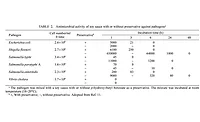Food Safety
Translating the 5S system to food safety
A method developed for operational efficiencies can help enhance food safety programs.
After visiting some 700 food processing facilities over the course of my career in the food industry, one of the most valuable programs I have seen these operations adopt is the 5S program. The concept was originally developed by the Japanese as a means for improving operational efficiencies, especially for ensuring just-in-time (JIT) manufacturing. In Japanese, the five S’s are: seiri, seiton, seiso, seiketsu and shitsuke.
These translate to:
- Sort
- Set locations
- Shine and sweep
- Standardizing
- Sustain
5S may be defined as a program to reduce operational steps and improve the overall cleanliness of a work area, making it safer and more productive. This definition can be expanded to say that development and implementation of the program can also enhance overall food safety and quality. The 5S program can be described simply as “Everything has a place, and everything is in its place.”
So, let’s take a look at how making a commitment to a 5S program can enhance your food safety program. The first step, sort, may be the most important. Sorting includes sorting unnecessary items and eliminating excess waste, which includes getting rid of broken, useless or redundant items. Processors should also utilize the sorting step to look at items throughout the facility and arrange materials based on how often they are used.
Plants that have adopted the program have reported that they eliminated the equivalent of four 20-ft. waste bins. Getting rid of unneeded, redundant, outdated or obsolete equipment, ingredients or whatever can provide extra space, eliminate potential pest harborages and reduce the probability of using the wrong item in the wrong place.
This may be even more important for small companies that often have a bad habit of keeping everything in hopes that they will use it one day. This would include old and outdated labels that, if used by accident, could result in a product recall. And, as a reminder, the use of improper, and often outdated labels, is a common cause of allergen recalls.
The second step is establishing locations for everything in the plant. In this step, the processor will arrange tools, equipment, ingredients and other materials with clear and defined markings, so they will be easy to find and readily available whenever they are needed. To clearly establish where different things should go, there are different tools available to the processor. These include signage, racking, shadow boxes or painting marks on the floor.
Processors must clearly define where everything should be located and work with their staff to ensure that things are put back where they belong. This is why shadow boxes and painted marks are so useful. One can tell at a glance whether something is missing.
One gap in many processors’ operations is the lack of a pallet management program. An integral element of such a program is clearly defining where and how pallets should be stored. Good-quality pallets should be stored in one place and damaged, dirty, infested or compromised pallets in another location. The key is to ensure that only good-quality pallets are used in production operations. Dirty or broken pallets can damage product or worse. Infested pallets have served as vehicles for in-plant pest infestations, and dirty pallets could bring pathogens into the facility.
In addition, when equipment, supplies and whatever else is easily accessible, there is a greater chance that operations will be done properly and efficiently. A very simple example that should be an integral element of preventive maintenance is tool reconciliation; what goes onto the floor to do a job comes back to the shop or into its place. Think of a surgical nurse who inventories all the surgeon’s tools before an operation and after. You want to be sure nothing is missing, as it may have been left in the patient.
The third step, shine and sweep, is more than just cleaning. It includes keeping the facility clean, maintaining equipment properly and according to established schedules, and making sure that the first two steps are kept up. Shine and sweep will become part of a company’s Master Cleaning Schedule, one of the most important prerequisite programs in any food safety management system.
To optimize this 5S step, consider dividing the plant into different areas and assigning responsibilities to different individuals to ensure that their area is not only clean, but that cleaning is properly documented. In addition, when documenting that cleaning has been done and done properly, the person conducting these inspections should not only look to see the work has been done, but examine the areas he or she is inspecting for potential problems and look for ways to further improve the system. What this means is that the workforce must be properly trained to do the cleaning and that the supervisors or inspectors are educated, so they can determine if the work has been done properly. And, of course, all this must be documented.
This leads to step four—standardizing. This is rather simple. It is when the first three steps are properly maintained. So, there are now cleaning and maintenance schedules, standards that the persons responsible for managing the different areas must live up to, check sheets to ensure that the work is not only done but done properly and assessments aimed at improving the system. In other words, the 5S system is subjected to an internal audit or verification program to ensure it is operating as designed.
And this leads to the last step—sustain. The goal of the program, as noted earlier, is to make the work environment safer and more efficient. When everything has a place and is returned to that place, it creates a workplace that is easier to work in, more pleasant to work in and one that is less prone to problems.
If your company elects to go the 5S route, it is imperative to get everyone involved, as this is a team approach to doing it right and more easily. Be sure and document not only the improvements but how the end result was achieved. Before, during and after pictures can create real “Wow” moments with management and staff. Make sure inspectors clearly understand what is expected. It is not just done; it has been done right.
Sustaining is where top management needs to be involved. They are the ones ultimately responsible for a company’s food safety and quality programs. They must be sure that the resources are available to not only get the program rolling, i.e., the first three S’s, but that they are committed to standardizing and sustaining the program. Management commitment is an essential element in most food safety programs, such as ISO 22000 and the various Global Food Safety Initiative (GFSI) food safety schemes. Maintenance of these programs is often difficult because people become complacent. Keeping your plant clean, uncluttered and easy to operate may not be deemed a prerequisite program to HACCP, but it sure makes the program easier to manage and maintain, especially when “Everything has a place, and everything is in its place.”
Looking for a reprint of this article?
From high-res PDFs to custom plaques, order your copy today!








